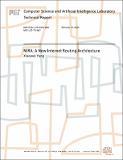NIRA: A New Internet Routing Architecture
Author(s)
Yang, Xiaowei
DownloadMIT-CSAIL-TR-2004-064.ps (165.4Mb)
Additional downloads
Other Contributors
Advanced Network Architecture
Metadata
Show full item recordAbstract
The present Internet routing system faces two challengingproblems. First, unlike in the telephone system, Internet users cannotchoose their wide-area Internet service providers (ISPs) separatelyfrom their local access providers. With the introduction of newtechnologies such as broadband residential service andfiber-to-the-home, the local ISP market is often a monopoly or aduopoly. The lack of user choice is likely to reduce competition amongwide-area ISPs, limiting the incentives for wide-area ISPs to improvequality of service, reduce price, and offer new services. Second, thepresent routing system fails to scale effectively in the presence ofreal-world requirements such as multi-homing for robust and redundantInternet access. A multi-homed site increases the amount of routingstate maintained globally by the Internet routing system. As thedemand for multi-homing continues to rise, the amount of routing statecontinues to grow.This dissertation presents the design of a new Internet routingarchitecture (NIRA) that simultaneously addresses these twoproblems. NIRA gives a user the ability to choose the sequence ofInternet service providers his packets traverse. It also has betterscaling characteristics than today's routing system. The design ofNIRA is decomposed into four modular components: route discovery,route availability discovery, route representation and packetforwarding, and provider compensation. This dissertation describesmechanisms to realize each of these components. It also makes clearthose places in the design where a globally agreed mechanism isneeded, and those places where alternative mechanisms can be designedand deployed locally. In particular, this dissertation describes ascalable route discovery mechanism. With this mechanism, a user onlyneeds to know a small region of the Internet in order to select aroute to reach a destination. In addition, a novel routerepresentation and packet forwarding scheme is designed such that asource and a destination address can uniquely represent a sequence ofproviders a packet traverses.Network measurement, simulation, and analytic modeling are used incombination to evaluate the design of NIRA. The evaluation suggeststhat NIRA is scalable.
Date issued
2004-10-14Other identifiers
MIT-CSAIL-TR-2004-064
MIT-LCS-TR-967
Series/Report no.
Massachusetts Institute of Technology Computer Science and Artificial Intelligence Laboratory